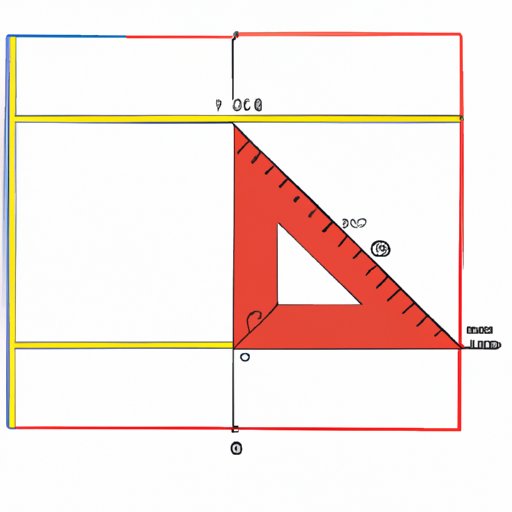I. Introduction
Whether you’re renovating your home or planning a garden, finding the area of a space can be a necessary task. Area is the measurement of how much space a two-dimensional shape covers, and it’s a foundational concept of geometry and math. In this article, we’ll take a step-by-step approach to finding the area, discuss real-life examples of when you might need to measure it, introduce visual aids that can make the process easier, explore different methods of finding the area, and highlight common mistakes to avoid.
II. A Step-by-Step Guide
First and foremost, it’s crucial to know how to calculate the area of a shape. Whether it’s a simple square or a more complex shape, the process is the same:
- Identify the shape: This can range from a rectangle or square to a circle or triangle.
- Measure the sides: Use a ruler or measuring tape to identify the length and width of the shape.
- Multiply the sides: Once you have the measurements, multiply the length and width together.
- Convert to proper units: Make sure your final answer is in the appropriate unit of measurement (square inches, square feet, etc.)
Let’s take a look at some common shapes and how to find their area:
- Square: A square has equal sides, so all you need to do is multiply one side by itself. For example, if one side measures 5 inches, the area is 25 square inches.
- Rectangle: Multiply the length and width together. For a rectangle that measures 6 inches by 8 inches, the area is 48 square inches.
- Triangle: Multiply the base by the height, and then divide your answer by 2. For a triangle with a base of 10 inches and a height of 4 inches, the area is 20 square inches.
- Circle: Multiply pi (π) by the radius squared (πr²). If the radius is 3 inches, the area is approximately 28.27 square inches.
By following these steps, you’ll be able to find the area of any two-dimensional shape.
III. Real-Life Examples
Finding the area comes in handy in numerous real-life situations. Here are a few examples:
- Measuring a room: When buying new flooring or paint for a room, it’s important to measure the area accurately so you don’t overspend. Measure the length and width of the room, and multiply those measurements together to find the area.
- Planning a garden: When planning a garden, you need to know how much space you have to work with. By measuring the area of the garden bed, you’ll know how many plants you can fit in the space.
- Purchasing land: If you’re purchasing land, it’s important to know the exact size of the property to ensure you’re getting the correct amount of land.
It’s important to note that finding the area of irregular shapes can be more difficult, but by breaking them down into smaller, simpler shapes, you can find the total area accurately.
IV. Visual Aids
Visual aids are a great tool for understanding the concept of area. They can include images, diagrams, and videos that provide a clear representation of the information. When used in an article on finding the area, visual aids can help readers understand the shapes and measurements more accurately.
For example, a diagram showing a circle split into smaller shapes can help visualize how to calculate the area of a circle. Likewise, a video that walks through the step-by-step guide can help those who learn visually better understand the process.
Incorporating visual aids in an article on finding the area can not only make the information more accessible, but it can also make learning the material more fun and engaging.
V. Methods of Finding the Area
There are various methods for finding the area, including:
- Using formulas: As demonstrated earlier, each shape has its own formula for finding its area.
- Counting squares: By drawing a grid over a shape, you can count the number of squares that it covers and multiply that number by the area of each square.
- Measuring with a ruler: Measuring the lengths and widths of a shape and multiplying them together, as outlined in the step-by-step guide.
While each method can work, some are more efficient than others depending on the situation. For example, counting squares may be more helpful for irregular shapes, whereas using the formula may be quicker for standard shapes like squares and rectangles. It’s important to consider the shape and your goal for quality measurements.
VI. Common Mistakes to Avoid
When measuring area, there are some common mistakes to be aware of:
- Measuring irregular shapes: As mentioned earlier, irregular shapes can be more difficult to measure, but by breaking them into smaller, simpler shapes, you can find the total area accurately.
- Avoiding rounding errors: When measuring, it’s important not to round any measurements until the final calculation to avoid introducing errors.
- Ensuring consistent units: Always ensure that all measurements are in the same unit (inches, feet, meters, etc.) before calculating the area to avoid errors in your final result.
By avoiding these common mistakes, you can ensure that your measurements are accurate and your calculations are correct.
VII. Conclusion
Knowing how to find the area is an important skill for both practical and academic purposes. By following the step-by-step guide and using visual aids, you can more easily understand how to find the area of any shape. Incorporating different methods of measurement can help you in different scenarios, and being aware of common mistakes to avoid can ensure that your measurements are correct.
As a final call to action, we encourage you to try measuring the area of different shapes in your everyday life to practice this skill and improve your overall accuracy.
